 |
 |
 |
 Travel & Outdoors | February 2007 Travel & Outdoors | February 2007  
Ten Affordable, Under-the-Radar Mexican Cities and Beach Towns
 Molly Feltner - SmarterTravel.com Molly Feltner - SmarterTravel.com

San Miguel

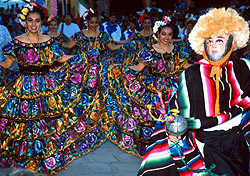 While San Miguel is more popular and pricey than the other colonial cities mentioned in this article, it deserves attention because it might just be the perfect destination in Mexico for travelers making the move from packaged beach-resort travel to do-it-yourself cultural travel. About 170 miles northwest of Mexico City in the Colonial Heartland, San Miguel has for decades been attracting foreigners who come to experience its wealth of arts and performance offerings. While San Miguel is more popular and pricey than the other colonial cities mentioned in this article, it deserves attention because it might just be the perfect destination in Mexico for travelers making the move from packaged beach-resort travel to do-it-yourself cultural travel. About 170 miles northwest of Mexico City in the Colonial Heartland, San Miguel has for decades been attracting foreigners who come to experience its wealth of arts and performance offerings.

"San Miguel not only has a rich historical heritage-the town has 400-year old Spanish colonial buildings and cobblestone streets-but also a cultural one as well," says Dianne Kushner, owner of Casa Luna B&B, located near the city center. "There is a large community of expatriates from all parts of the world who live in San Miguel and contribute to its cultural diversity. It's a favorite of artists and photographers who love the vibrant colors, interesting people, and the market and street scenes. The town is awash with numerous shops and galleries, and there is usually at least one fiesta each weekend."

The city is not famous for any one attraction in particular, as its highlights are mostly experiential: Try strolling El Jardin Principal (the central square) in the evening, when musicians and children come out to play or people-watch at an outdoor cafe over a plate of fiambre (a dish of fruits, vegetables, and meat). Browse the artisans' stalls at the Mercado de Artesanias or attend a festival. Consider taking a Spanish language or arts course at the Instituto Allende.

Getting there: The nearest major airport is located 75 miles away in Guanajuato. Sample summer fares from Houston to Guanajuato start around $300 plus taxes on American. You can rent a car or take a first-class bus (about $10) to get to San Miguel.

Where to stay: Rates at the 25-room Casa Luna, a restored 18th-century villa that exudes the romance of old Mexico, start at $135 per night, including a full breakfast. Rooms are decorated with folk art and have fireplaces, private bathrooms, feather beds, and comfortable furniture.

Online resources: Learn more by visiting SanMiguelGuide.com, PortalSanMiguel.com, or MercadoSanMiguel.com.

San Cristóbal de las Casas

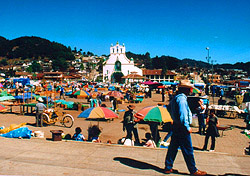 To experience some of most authentic indigenous culture in Mexico, head down to the country's southernmost state, Chiapas, where the Mayan population holds on to traditional ways more tenaciously than anywhere else in the nation. The most popular city for visitors in Chiapas, San Cristóbal de las Casas, although founded as a colonial Spanish city, is surrounded by indigenous villages and a good starting point for those wishing to learn more about the region's indigenous populations. To experience some of most authentic indigenous culture in Mexico, head down to the country's southernmost state, Chiapas, where the Mayan population holds on to traditional ways more tenaciously than anywhere else in the nation. The most popular city for visitors in Chiapas, San Cristóbal de las Casas, although founded as a colonial Spanish city, is surrounded by indigenous villages and a good starting point for those wishing to learn more about the region's indigenous populations.

San Cristóbal de las Casas has the typical attractions of a Mexican colonial city, but the vibrant procession of traditionally dressed Mayans who come to the city to sell crafts and produce are much more fascinating. For a full sensual immersion into the city's indigenous commerce, go to the Mercado Municipal (central market), where you'll see table after table heaped with fresh produce and meat, medicinal herbs, flowers, coffee, and intricately woven textiles. Plan to stop by Na Bolom, a nonprofit cultural association dedicated to preserving Chiapas culture and ecology. Its museum and library displays Mayan artifacts and thousands of documents on the indigenous people of Chiapas. A guesthouse, restaurant, and shops are also on-site.

From the city, you can start exploring Mayan villages. "I recommend visiting San Juan Chamula and Zinacantán," says Fanny Stoquet, services manager at Na Bolom. "Both villages speak the same language (Tzotzil) and are near one another, but very different. Zinacantán is a Catholic village with a Catholic church. [The villagers] cultivate flowers for export, and the women are good weavers with flowers as their principal design. San Juan Chamula has a very special church and religion, a mixture of Catholic and pre-Hispanic traditions." Na Bolom runs daily guided visits to both for about $15 per person. Most other hotels can also arrange minibus or horseback tours of the villages. Going with a guide is highly recommended, as you'll learn more and know what cultural blunders to avoid.

Getting there: From the U.S., fly to Tuxtla-Gutierrez, the nearest major airport, and take a taxi to San Cristóbal (90 minutes, about $50). Cheaper buses are also available. Sample fares from Houston start around $600, excluding taxes, on AeroMexico.

Where to stay: Decorated with Mayan artwork, textiles, and photographs, the 16 rooms of Na Bolom's guesthouse are an extension of its museum. Rates start at $50 per night and include breakfast.

Online resources: Learn more by visiting the Cristóbal resource pages on the Mexico Tourism Board website, Mexperience.com, and MEXonline.com.

Isla Mujeres

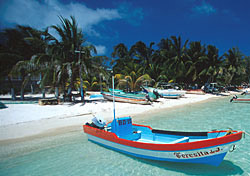 In all likelihood, if you're planning a Mexico vacation, it's going to be to Cancun, Mexico's most popular destination for Americans. But, when you grow weary of getting lost in your mega resort, fighting off frat boys for a spot at the wet bar, and spending lots of money on Mexican meals that taste like reheated leftovers from Chili's, it's time to go to Isla Mujeres (Island of Women) - the perfect antidote for all of Cancun's madness. In all likelihood, if you're planning a Mexico vacation, it's going to be to Cancun, Mexico's most popular destination for Americans. But, when you grow weary of getting lost in your mega resort, fighting off frat boys for a spot at the wet bar, and spending lots of money on Mexican meals that taste like reheated leftovers from Chili's, it's time to go to Isla Mujeres (Island of Women) - the perfect antidote for all of Cancun's madness.

"Cancun visitors should check out Isla Mujeres because it's easy to get to from the Hotel Zone and makes for a perfect overnight side trip or just a day trip," says SmarterTravel's Executive Editor Anne Banas, who's visited the island several times. "Worlds away from Cancun, Isla Mujeres offers a more laid-back Mexican experience where you can find authentic Mexican food, small locally owned shops, and quiet beaches."

Tiny-only one kilometer wide and seven kilometers long-Isla's charms can easily be explored in a day, using a moped or golf cart to get around. The main town (where the ferries dock) is filled with restaurants serving good, cheap Mexican food. Try La Adelita on the main drag, which serves tasty meals and more than 150 different tequilas. The town is within walking distance of the beaches, where you'll also find casual eateries and bars. "The 'Swing Bar' on North Beach is a great place to relax and have a cocktail," says Banas. "There are three separate bars clustered together, each with swings for chairs, and each with a two-for-one happy hour at different times throughout the afternoon."

Driving around the island, you'll see mostly private homes, B&Bs, and rocky coastline, although it's worth stopping at Punta Sur, the southernmost point of the island. "Punta Sur has been turned into a visitor park complete with a sculpture garden, the Mayan ruins of Ixchel, the goddess of fertility, and an incredible stone path that winds down a rocky cliff to the crashing surf," says Banas.

Getting there: To get to the island from the Hotel Zone, take a taxi to Puerto Juarez (about $15) and hop on a ferry. Round-trip tickets cost about $7. Sample summer fares to Cancun from Miami start at $178 plus taxes on American.

Where to stay: "Although there are many nice hotels in the main town or North Beach area, I prefer staying on the breezy Caribbean side where hotels are more like sleepy beach houses," says Banas. "Villa Las Brisas, owned by expats, is a fun and peaceful retreat where you can relax by the pool or in the giant open-air living room. The guest rooms have festive Mexican decor with elements to remind you that you're on an island, like hammocks, conch-shell showerheads, and ceiling fans." Rates start at $110 per night.

Online resources: For more details, read Anne Banas' column on Isla Mujeres, or visit Isla-Mujeres.net or IslaMujeres.info.

Zacatecas

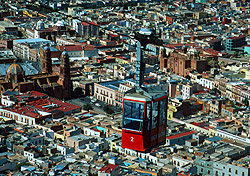 Set within a narrow valley at 8,200 feet in the north-central highlands - Mexican cowboy country - the colonial city of Zacatecas almost seems to have arisen arbitrarily. But the town's existence is no mistake. The Spanish found silver here in 1546 and, flush with riches, they built one of the most architecturally splendid colonial cities in Mexico. Set within a narrow valley at 8,200 feet in the north-central highlands - Mexican cowboy country - the colonial city of Zacatecas almost seems to have arisen arbitrarily. But the town's existence is no mistake. The Spanish found silver here in 1546 and, flush with riches, they built one of the most architecturally splendid colonial cities in Mexico.

Declared a UNESCO World Heritage Site in 1993, the historic center is famous for its pink-limestone buildings, particularly its baroque cathedral, which combines European and indigenous decorative elements. Also notable are the Templo de Santo Domingo, the ex-Convento de San Francisco, and the Palacio del Gobierno.

But there's more here than fancy buildings. "The Teleferico and the Cerro de la Bufa are definitely worthwhile," says Canadian writer Julie Hawrishok, who visited the city with her parents. The Teleferico cable car traverses the city from the El Eden silver mine to the Cerro de la Bufa, site of the revolutionary Pancho Villa's 1914 victory over the army of dictator Victoriana Huerta. "The Cerro de la Bufa has the best view of the city, plus huge statues, including one of Pancho Villa. A tour of the El Eden mine is interesting as well. Our tour guide … was able to give us an in-depth history of the mining industry and the city."

Zacatecas' out-the-way location seems to keep the number of international tourists low, which may make it attractive to you if you're really after "untainted" Mexico. "I saw few Americans, Canadians, and Europeans in Zacatecas-it was almost as though we were the only ones," says Hawrishok of her December visit. Just brush up on your Spanish before going.

Getting there: Zacatecas has its own airport, located north of the city. Summer fares from Houston start around $400, excluding taxes, on American. Taxi rides into the city cost about $15.

Where to stay: Rates start around $63 per night at the Hostal del Vasco, located near the city center, which has 18 suites and eight furnished apartments.

Online resources: Learn more by visiting the Zacatecas resource pages on the Mexico Tourism Board website and Mexperience.com.

Troncones

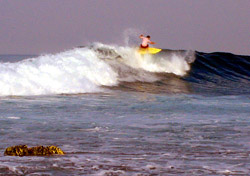 On Mexico's Pacific Coast, where beach resorts like Cabo San Lucas, Puerto Vallarta, and Acapulco now sprawl over once-virgin beaches with high-rise hotels, golf courses, and shopping malls, it's nice to know at least a few stretches of perfect sand remain undisturbed by the big developers. Troncones, a small fishing village located just a half hour from the resort of Ixtapa, is one of them. On Mexico's Pacific Coast, where beach resorts like Cabo San Lucas, Puerto Vallarta, and Acapulco now sprawl over once-virgin beaches with high-rise hotels, golf courses, and shopping malls, it's nice to know at least a few stretches of perfect sand remain undisturbed by the big developers. Troncones, a small fishing village located just a half hour from the resort of Ixtapa, is one of them.

It's easy to miss the signs on Highway 200 pointing towards the crumbly road heading west towards the beach and Troncones, but ask anyone with a surfboard for directions, and they'll point out the right way. People come to Troncones for a few simple reasons: great surfing, great beach, great eating, and few tourists.

Troncones is home to several hundred local families and a number of small inns, guesthouses, and restaurants. The Inn at Manzanillo Bay is one of the most well-known establishments, boasting probably the best restaurant in town and its own surf shop, in addition to 10 thatched-roof bungalows. It also has a good location on Manzanillo Bay, one that's ideal for both swimmers and surfers: "The beach out in front of the inn is set on a bay that's protected from currents and rip tides, which is great for swimming and snorkeling," says Manager Randall Brook. "We also have great surfing in front of the inn via a point break and reef."

As for dining, people come all the way from Ixtapa just to eat at the inn's restaurant. The chef (and hotel owner) Michael Bensal combines classical European cooking with local cuisine, creating dishes such as sautéed fish with tequila-lime sauce and grilled filet mignon fajitas. The inn also rents surfboards and snorkel gear, and can arrange private surf lessons for about $50.

Getting there: Troncones is about a 40-minute drive from the Zihuatanejo-Ixtapa airport. It's easiest to either rent a car or take a taxi (about $70) to get there. Sample fares from Houston to Ixtapa start at around $300, excluding taxes, on American this summer.

Where to stay: Summer rates at the Inn at Manzanillo Bay start at $88 for oceanview bungalows, which include a private patio, canopy beds, and hammocks. Sightseeing tours, horseback riding, and other activities can be arranged for a fee.

Online resources: For more information, go to Troncones.net or Troncones.com.mx.

Merida

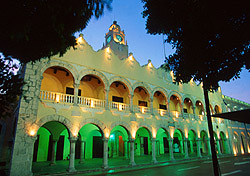 There's more to the Yucatan than beaches and Crayola-colored libations-there's Mayan archaeological sites, colonial architecture, and a landscape of tropical forests, wetlands, caves, and still-hidden ancient ruins, too. To best explore these attractions, and experience a real Mexican city with worthy sites of its own, head inland from Cancun and make the colonial city of Merida your base. There's more to the Yucatan than beaches and Crayola-colored libations-there's Mayan archaeological sites, colonial architecture, and a landscape of tropical forests, wetlands, caves, and still-hidden ancient ruins, too. To best explore these attractions, and experience a real Mexican city with worthy sites of its own, head inland from Cancun and make the colonial city of Merida your base.

Known as the White City, Merida was built on top of the ancient Mayan city of T'Ho, and some of the ruins' white-limestone blocks are still visible in the facades of Spanish colonial buildings, including the cathedral. Start your explorations at the zócalo (central square), where you can browse street vendors, listen to Mayan musicians or sit and watch the parade of locals going about their daily business. On weekend evenings, the zócalo and its surrounding blocks play host to lively bands and folkloric dancers until late. For some history, be sure to stop by the Cathedral de San Ildefonso, the oldest cathedral in North America, and the Museo de Antropologia (Anthropology Museum), which offers lots of background information on the Mayans.

From Merida, you can take day trips to Iztmal, a smaller town with a huge yellow convent built on top of a Mayan pyramid; the Celestun Biosphere Reserve, a protected wetland area home to thousands of pink flamingos; the ruins of Dzibilchaltún; and Progreso, Merida's weekend beach escape. Merida is also the departure point for road trips to see some of the Yucatan's less-visited (but some would say more interesting) Mayan ruins, including the massive Uxmal, and the sites of the Puuc Route: Kabah, Sayil, Xlapak, Labná, and Loltún (a cave system). You can visit most of these places on organized tours, but renting a car will allow you more freedom.

Getting there: Sample fares on Delta from Miami start around $430, plus taxes, in the summer. To save money, consider flying to Cancun (about $178 plus taxes from Miami) on American) and renting a car. Merida is about 315 kilometers away on the toll highway.

Where to stay: A very good value for your money, the cheap but nice Hotel Dolores Alba has 100 rooms with private bathrooms from a mere $35 per night. It also has covered parking-a huge plus in this sometimes traffic-choked city.

If you have a bit more cash and a rental car, SmarterTravel.com Contributing Editor RaeJean Stokes highly recommends staying in a Spanish hacienda estate. "There are some gorgeous haciendas that have been converted into hotels on the outskirts of town," she says. "They're pretty unique, and some are five-star establishments with great food and atmospheric surroundings." The Hacienda San Pedro Nohpat is one less-fancy option that won't break the bank (rates from $85 per night).

Online resources: For more information, go to the Merida guides on MexOnline.com, YucatanToday.com, and Mexperience.com. | 
 | |
 |



